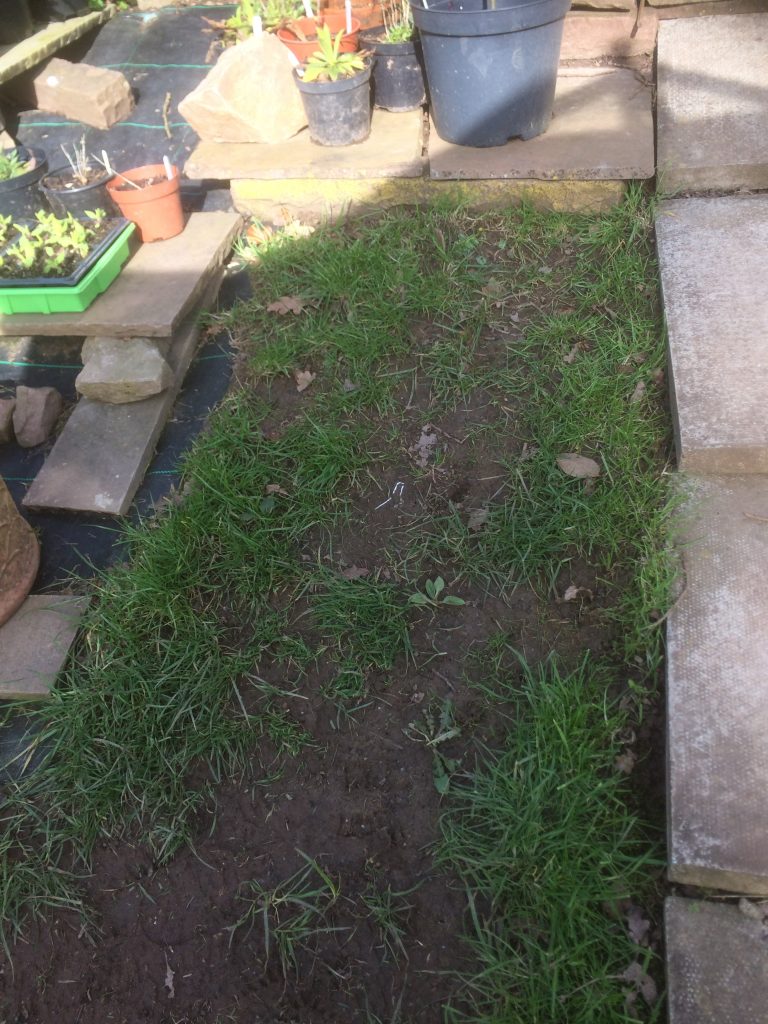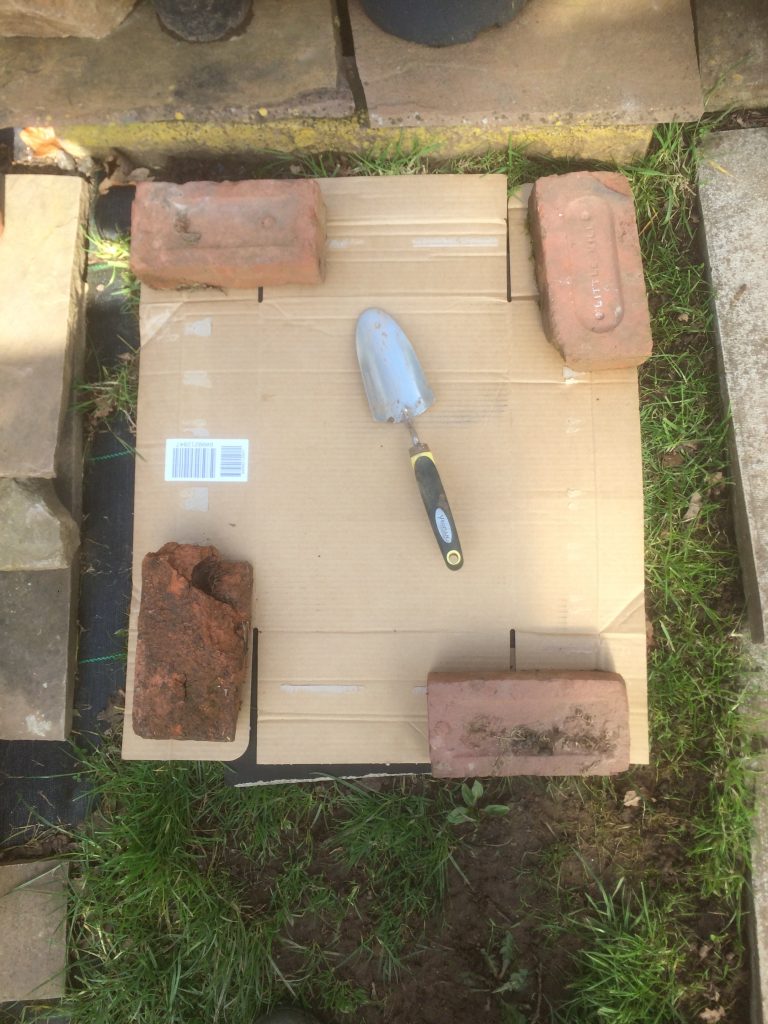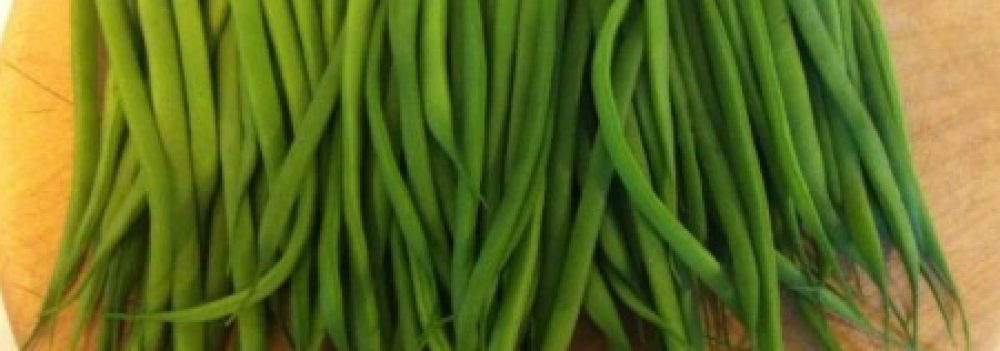We can grow delicious vegetables pretty much anywhere and at virtually no cost,
I am starting this post on 23rd March to help anyone who has even the roughest patch of garden, however large or small, to start growing a few delicious, healthy vegetables. I am doing this myself to demonstrate how easy and trouble free it can be. The first thing to do is select a site. Ideally you want to grow your vegetables in the sunniest and warmest part of your garden.. However, even if the ground is shaded you can still grow lots of great veg.
This is the spot of rough grass I have chosen.

The only tool I will be using to start with is a hand trowel, and I won’t need that for the next month. I need to cover the patch of ground with something that will suppress the grass and weeds. I have chosen a cardboard box, which when opened out measures 70cms x 60cms, (2’8″ x 2”) more than enough space for me to grow a few dwarf French beans. A few bricks I had lying around will keep the cardboard firmly in place. If you don;t have any cardboard alternatives that will do the job just as well are bits of old carpet or black polythene.

If you have never grown any veg before, my advice would be to start with just a small patch which you can expand as and when you feel able to and most importantly, when you are enjoying the experience of growing some of your own food! You will be amazed at how much you can grow in a small space. If you can cover a piece of ground 1 metre by 2 metres that will be an ideal start.
The most important part of growing food is the soil. Even the poorest of soil will grow something. Gardeners like to add organic material like manure or compost to improve the soil and fertilisers like fish, blood and bone. But it you don’t have any of these things it really doesn’t matter. Improving one’s soil is an ongoing process and the very act of growing vegetables will help to the soil anyway. If your patch is full of stones or rubble and you are able to remove the worst of it, then please do. If the ground is very weedy, especially if you have perennial weeds like nettles, docks, dandelions and brambles growing in it, then you will need to remove as much of these as you can. If your patch is just a neglected bit of your garden you might like to trim any weeds or grass – if necessary using some old scissors if you don’t have shears or a strimmer – but worry not. The most important thing is to exclude all light, which will stop all but the most persistent of weeds from growing. This preparatory work done, there is nothing more you need to do to the ground until you want to plant in early May.
So what are you going to grow? If your new patch is in a warm and sunny spot I would recommend starting with dwarf French beans. They are ready to be harvested from as little as two months after sowing, heavy cropping and very easy to grow. Beans like the soil to be warm too. If your plot is in a more shaded area then one crop that will grow quite happily is lettuce. So, whilst the cardboard is stopping the weeds and spring is yet to get into full swing, we can, non the less, start off beans and/or lettuce in the house, easily and very cheaply. So, start saving all your loo rolls as they make ideal starter pots. Also any small plastic pots like yoghurt and even those baked bean tins that normally go to recycling are ideal for beans. A small plastic food tray that is at least 2.5cms, (1″ deep) will do for lettuce. You will need to make a few small drainage holes in the bottom of any pots, tins and trays. If you are saving loo rolls you will need an old plate to put them on when it comes to sowing. Now for the seeds. 12 bean plants, enough to provide several meals over 6 weeks, will take up an area of 60 cms by 80 cms (2′ x 2’6″) so I will hope to grow 10 plants on my little patch. Lettuce can be spaced as little as 15cms apart. A packet of dwarf French bean seed, which costs between £2.50 and £3.00 contains up to 200 seeds, A packet of lettuce seeds costs under £2 and can contain as many as 1000 seeds, so one packet is enough for you and your neighbours. Any you don’t use this year can be kept in an airtight container somewhere cool- ideally your fridge – and be used next season.
If growing lettuces, you will want to dig up enough soil from your garden to fill a small plastic container. Try and remove and stones and all weeds from the soil and crumble it up as finely as you can. You only need to sow a pinch or two of seeds. Level out the soil in your tray to just below the top and sprinkle seeds very thinly on the surface When I say thinly I mean allow about roughly 1cm between each seed. lIghtly cover the seeds with a little more soil and gentle water. Put the tray on a warm and sunny windowsill. Keep an eye on the soil to be sure it doesn’t dry out. Equally, you don’t want it to be water-logged. Just nice and damp. Within a week you should see teh first signs of seedlings emerging. What to do next will be in my next post.
You will want to start off your beans in pots of soil which you have collected from the garden in the next couple of weeks or so. Lettuce seeds can be sown now. The first place to go for seeds is your nearest garden centre or ask a friend or neighbour if they have any spare. Otherwise you can buy online. My favourite catalogue is www.organiccatlogue.com Another very good company is http://www.marshalls-seeds.co.uk
For fantastic information and help with growing when you have few, if any resources visit http://www.gardenorganic.org.uk
If you have any questions please contact me through the website Ask Adam section. For people who live near me, I am able to provide some small quantities of seeds and you can always check out my seed list on the website. Next episode will be all about sowing seeds.
